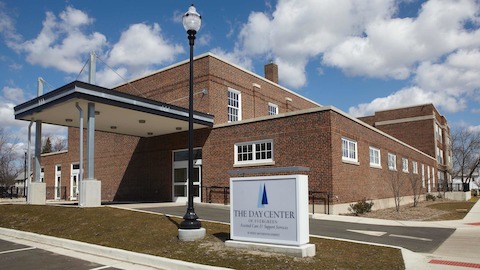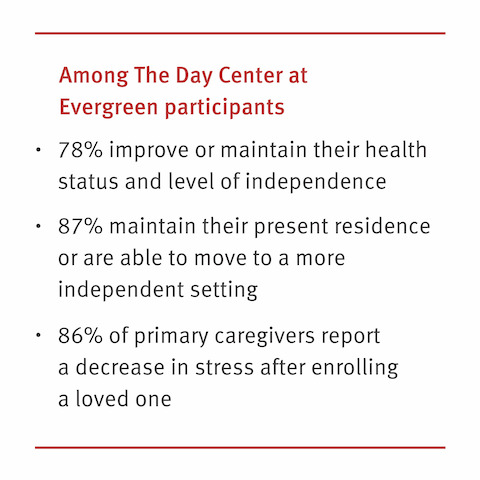The Day Center of Evergreen
Environment key to creating a great day center experience for adults
Holland, Michigan, US
Photo credit: David Ellison
Download PDF (633.7 KB)
The demand for healthcare services for older adults continues to rise as the population ages and life expectancy hits new heights. Today, programs and services that may not even have existed 30 years ago are striving to meet unprecedented needs. Like day centers, for example, which provide a safe, caring environment and a daytime community for older people with health impairments, such as dementia, which may result in isolation and lack of social activities.
One of the earliest pioneers in the field is The Day Center of Evergreen (Evergreen Commons, a non-profit organization), which began providing daytime programs for seniors in the 1980s, when only a handful of such programs existed in the state.
About half of those served at the facility have dementia; other conditions range from Parkinson’s to depression. Most participants require some form of assistance or supervision.
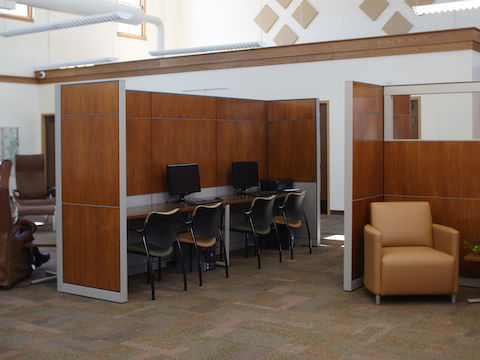
Easy-to-move Aside chairs and Everywhere tables were used to create computer stations for participants near the library.
The Day Center also provides much-needed services, such as training and respite, for caregivers—typically a family member who is caring for a spouse or parent—at home. (Note: It’s estimated that there are roughly 42 million unpaid caregivers in the U.S.)
Increasing Demand
Over the years, The Day Center would outgrow its space, expand, outgrow it again, expand again, until they finally reached the point where they had to find a new location. As Director Jo Ver Beek explains, “When I started here 18 years ago, we had about 12 participants in our Day Center program; by the time we started looking for a new facility we were averaging 45-50 people a day.”
The timing for a move was perfect; just a few short blocks away, a gymnasium, which was part of a junior high school that had served the community for nearly a century, had become available.
Turning the cavernous 12,000-square-foot-space into a warm and welcoming place for adults needing assisted care was a job for seasoned professionals. Architectural firm Hooker De Jong, which has a long history of designing healthcare facilities for older adults, and Herman Miller dealership Work Squared, with its extensive experience in healthcare environments, proved to be ideal choices.
Evergreen Commons President/CEO Dave Knibbe says a great deal of thought and planning went into the project before the design work began. “When we realized we had the opportunity to create a whole new space starting from scratch we asked ourselves, ‘What can we do to make it the best day center experience for our participants?’”
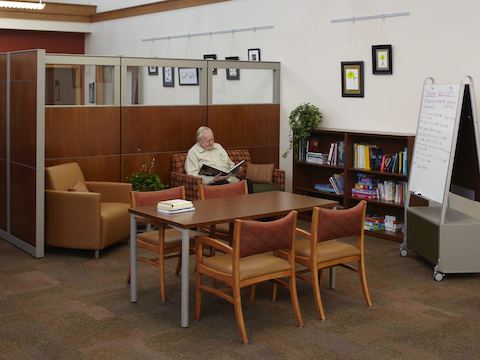
The Pamona Lounge grouping, which tucks neatly into small spaces, offers comfortable seating in the library; Altair chairs pulled around an Everywhere table give people a spot to gather.
Program, Place, People
The three P’s—program, place, and people—are the key factors that influenced this outcome. “All three factors need to work together in concert to give participants the best experience,” says Knibbe, emphasizing that congruency is essential. “If we have great programs and people (staff and volunteers) but our space doesn’t complement the experience we wish to provide, then we’re not accomplishing our goal, and that’s what was happening at our former facility.”
With nearly 20 years of experience, Ver Beek was a valuable resource in the planning. Her overarching goal was that The Day Center support their long-held philosophy of “honored care,” which means treating each individual with respect and dignity.
“Although someone may have a physical or mental impairment, we provide the same care we would give any fully functioning human being,” says Ver Beek. “We are very careful about not objectifying our participants; even if they aren’t capable of talking with us, it’s our job to connect with them any way we can.”
The environment, including furniture designed specifically to meet the needs of participants, staff and volunteers, was very important, she emphasizes. “Oftentimes furnishing a day center is an afterthought, or they get leftovers: Put something in and call it good. But I was very adamant about making it nice for our participants. I didn’t want them to feel like second class citizens in any way.”
Power Of Space
Herman Miller Healthcare Marketing Director Cheryl Carpenter knows the power of a well-designed space. “When you walk into a good space, you know it; it has a huge impact on how people feel. It doesn’t necessarily have to be expensive. But you have to think about your space and be smart about what goes in it. It all matters. It means designing environments that consider the human side, how participants interact, how the staff will use it, and also how the family caregivers feel about it: Does it have the dignity their loved ones deserve? The Day Center is a great example of how this type of thinking, early on in the process, made it all come together to achieve an incredible experience that creates more independence for participants and less stress for families.”
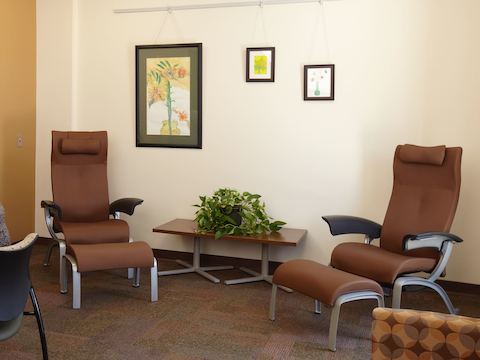
Nala patient chairs, shown here with ottomans, incorporate innovative ergonomic principles to provide extra comfort and support.
Work Squared provided interior design services as well as furnishings. Designer Laura Kinne consciously chose a warmer color palette for carpets, walls, seating, throw pillows, and other details, “anything to make it feel more residential; we did not want it to feel institutional at all.”
Kinne says that the huge product offering from Herman Miller and Nemschoff meant that they could get most of what they needed from one source, from dining and lounge seating to treatment chairs to office furniture to exam room furnishings to movable tables.
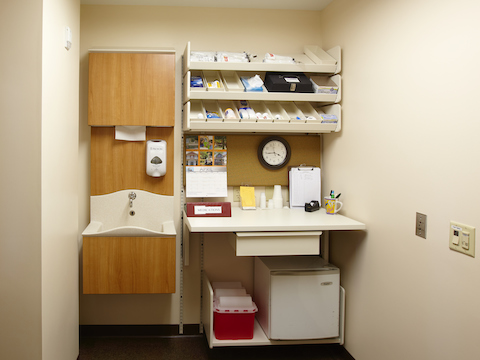
Compass, Herman Miller Healthcare’s modular system of interchangeable components, can easily be reconfigured as needs change in the med room.
Having A Great Day
The vibe at The Day Center, where their motto is, “Have a great day!”, is indeed a happy one as participants interact with one another and with staff in various activity rooms—a music lesson may be going on in one room; an art class in another.
The large open space that greets visitors feels much like a hospitality room, with lots of tables and different seating areas, while clerestory windows provide plenty of welcoming natural light. There’s a bright, sunny exercise room, a kitchen for classes, game tables, a library and a computer area.
The gym’s former locker room now houses staff offices, where Canvas Office Landscape gives the area a clean, contemporary look. Nearby are private areas for performing assessments and evaluations; there are even special bathing and laundry facilities.
Architect David Layman is particularly impressed with the Herman Miller’s Compass wall-hung system, a modular system of interchangeable, flexible components, which was used in the exam rooms. “It’s very functional and innovative, and gives The Day Center the ability to make changes in the future,” he notes.
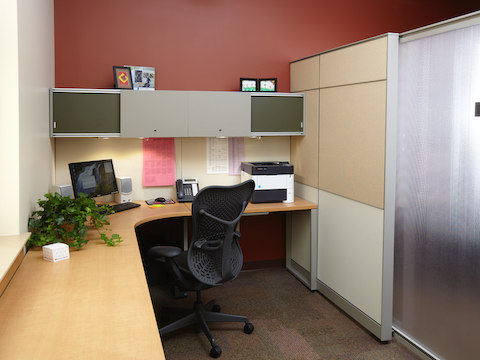
Canvas Office Landscape and Mirra chairs provide a professional environment for staff in what used to be the gymnasium’s locker room.
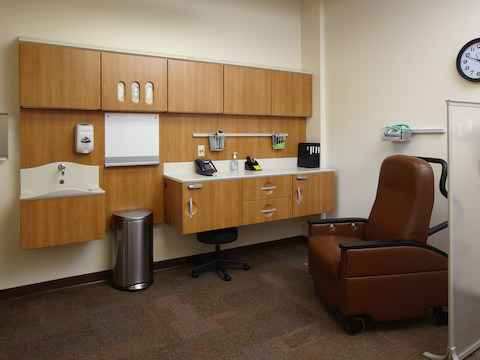
Flexible and functional, Compass works well in a wide range of clinical spaces; staff and residents appreciate how easily the Pristo II Treatment chair moves from one position to another.
Heatlthcare Materials Critical
It was critical that seating fabrics meet health codes with moisture barriers for cleanability and sanitation. That meant chairs wouldn’t require protective pads, which can be embarrassing for participants. Kinne appreciates that Nemschoff and Herman Miller offer such a wide variety of colors, prints, and patterns in the required healthcare specific materials, “so we had lots of choices to work with and we could tie everything together to give it a truly cohesive look throughout.”
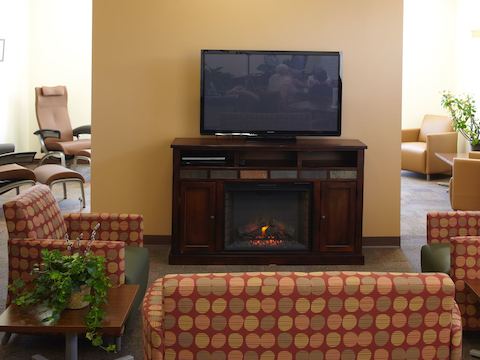
Nemschoff offers a wide variety of fabrics that meet healthcare standards to help make The Day Center warm and inviting for participants, caregivers, and staff.
Clean, Crisp, and Comfortable
Layman feels the Work Squared team more than achieved their goal. “The Day Center really breaks the mold of what you’d expect. It’s anything but ‘sterile.’ It’s modern; it’s got a lot of vitality and zip to it, and it feels clean and crisp. At the same time, it’s very comfortable.”
The $1.5 million renovation, which has the capacity for up to 100 participants a day, was also a historic preservation project, so the designers and architect were required to follow State Historic Preservation Office guidelines in order to get federal tax credits. Layman adds that Work Squared did a great job working under those constraints.
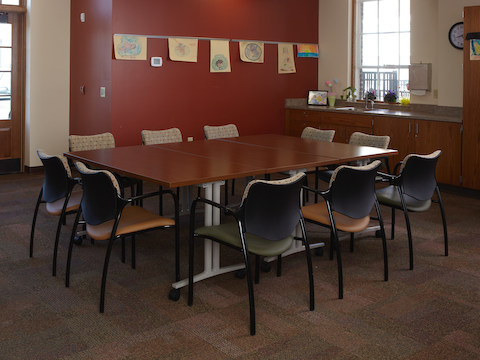
Everywhere tables and Aside chairs are ideal in the arts and crafts room because they can be quickly moved around and reconfigured to meet a variety of needs.
Staff Appreciates Support
The Day Center staff really appreciates how the furniture supports both the participants and their own work. For example, Ver Beek says everyone loves the Nala patient chairs, which comfortably support the participants’ bodies and the Hospitality Island, a 3-shelf stand, which employees use as a “touchdown” space to write notes on charts. The Islands are on casters and can be moved around to wherever they’re needed.
Ver Beek is grateful for the help she received from the Work Squared team in making the selections. “I had never done anything like this before, so it was a little overwhelming to me at first, sitting with the architects trying to figure it all out. But the Work Squared reps were phenomenal; they held my hand and narrowed down my choices with great product recommendations from Nemschoff and Herman Miller Healthcare, so it wasn’t so confusing. And it went beyond just picking out the furniture, they helped me throughout the entire process.”
The result, everyone agrees, is spectacular. And it seems only right that this historic site continues to serve the needs of the community’s citizens, some of whom may even have shot a few hoops in the same spot where they now enjoy so many other activities.
“It’s wonderful that after so much thinking and planning, we ended up with exactly what we wanted: a very customer-focused space that beautifully supports our honored care philosophy,” summarizes Knibbe.
As demand for these types of facilities continues to grow, The Day Center of Evergreen makes an ideal model for doing things the right way by considering all the factors that make up a great experience—especially the important intersection of program, place, and people.
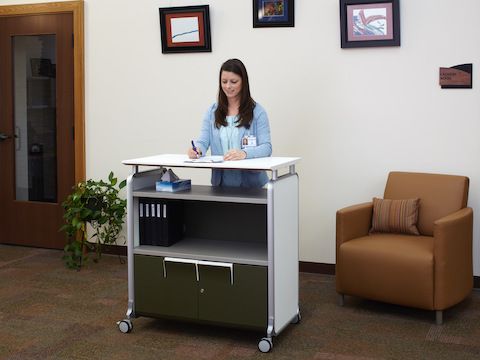
Nemschoff offers a wide variety of fabrics that meet healthcare standards to help make The Day Center warm and inviting for participants, caregivers, and staff.
